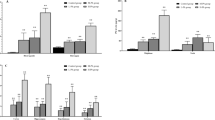Abstract
Objective
Study the effects of acute and chronic restraint stress on the whole blood concentrations of iron (Fe), zinc (Zn), calcium (Ca), and magnesium (Mg) in mice.
Materials and methods
Single or repeat restraints were applied to mice to induce acute or chronic stress. The levels of elements in whole blood were determined by flame atomic absorption spectrometry.
Results
The levels of Fe, Zn, Ca, and Mg in blood in the acute-stress group were 351, 5.05, 60, and 44 μg/ml, respectively, and those in the corresponding control group were 391, 5.90, 59, and 45 μg/ml, respectively. The levels of blood Fe, Zn, Ca, and Mg in the chronic-tress group were 291, 3.62, 59, and 40 μg/ml, respectively, and those in the corresponding control group were 393, 4.82, 48, and 43 μg/ml, respectively. The levels of Fe and Zn in the blood of both the acute-stress and the chronic-stress groups were significantly lower (P < 0.05) than that in the control groups. The Ca level in whole blood was significantly (P < 0.05) higher in the chronic-stress group than that in the control group.
Conclusion
Acute and chronic restraint stress can cause changes in blood levels of Fe and Zn in mice.
Similar content being viewed by others
References
Gold SM, Mohr DC, Huitinga I, Flachenecker P, Sternberg EM, Heesen C (2005) The role of stress-response systems for the pathogenesis and progression of MS. Trends Immunol 26(12):644–652
Starkie RL, Hargreaves M, Rolland J, Febbraio MA (2005) Heat stress, cytokines, and the immune response to exercise. Brain Behav Immun 19(5):404–412
Holsboer F (2001) Stress, hypercortisolism and corticosteroid receptors in depression: implications for therapy. Affect Disord 62(1–2):77–91
Reiche EM, Morimoto HK, Nunes SM (2005) Stress and depression-induced immune dysfunction: implications for the development and progression of cancer. Int Rev Psychiatry 17(6):515–527
Brown MR, Smith AW (2001) Dormancy and persistence in chronic infection: role of the general stress response in resistance to chemotherapy. J Antimicrob Chemother 48(1):141–142
Apostoli P (2002) Elements in environmental and occupational medicine. J Chromatogr B Analyt Technol Biomed Life Sci 778(1–2):63–97
Ishihara Y, Iijima H, Yagi Y, Hoshi H, Matsunaga K (2004) Inhibition of decrease in natural killer cell activity in repeatedly restraint-stressed mice by a biological response modifier derived from cultured mycelia of the basidiomycete Tricholoma matsutake. Neuroimmunomodulation 11(1):41–48
Markova OO, Mysula IR, Bodnar Kvik I II, Borys AP (1995) The content of macro- and trace elements in the cardiac muscle of adult and old rats after stressor influence. Fiziol Zh 41(1–2):100–104
Okur H, Kucukaydin M, Ustdal KM (1995) The endocrine and metabolic response to surgical stress in the neonate. J Pediatr Surg 30(4):626–625
Hidalgo J, Garcia A, Oliva AM, Giralt M, Gasull T, Gonzalez B, Milnerowicz H, Wood A, Bremner I (1994) Effect of zinc, copper and glucocorticoids on metallothionein levels of cultured neurons and astrocytes from rat brain. Chem Biol Interact 93(3):197–219
Wysocki A, Beben P, Winiarski M (1998) The effect of surgical trauma on the level of plasma iron. Przegl Lek 55(10):508–511
Luo W, Chen J, Jiang H, Chen Y (2004) Effects of zinc on content of uncoupling protein in cold stress rats. Wei Sheng Yan Jiu 33(1):33–35
Fabris N, Mocchegiani E (1995) Zinc, human diseases and aging. Aging (Milano) 7(2):77–93
Lieu PT, Heiskala M, Peterson PA, Yang Y (2001) The roles of iron in health and disease. Mol Aspects Med 22(1–2):1–87
Takase B, Akima T, Uehata A, Ohsuzu F, Kurita A (2004) Effect of chronic stress and sleep deprivation on both flow-mediated dilation in the brachial artery and the intracellular magnesium level in humans. Clin Cardiol 27(4):223–227
Liashenko VP, Lukashov SM (2003) Effect of stress on calcium homeostasis in muscular tissues. Fiziol Zh 49(5):76–81
Joels M, Velzing E, Nair S, Verkuyl JM, Karst H (2003) Acute stress increases calcium current amplitude in rat hippocampus: temporal changes in physiology and gene expression. Eur J Neurosci 18(5):1315–1324
Acknowledgment
The study was supported by grant NSFC-30370484 (Liu) from the National Natural Science Foundation of China.
Author information
Authors and Affiliations
Corresponding author
Rights and permissions
About this article
Cite this article
Teng, Wf., Sun, Wm., Shi, Lf. et al. Effects of Restraint Stress on Iron, Zinc, Calcium, and Magnesium Whole Blood Levels in Mice. Biol Trace Elem Res 121, 243–248 (2008). https://doi.org/10.1007/s12011-007-8047-x
Received:
Revised:
Accepted:
Published:
Issue Date:
DOI: https://doi.org/10.1007/s12011-007-8047-x




